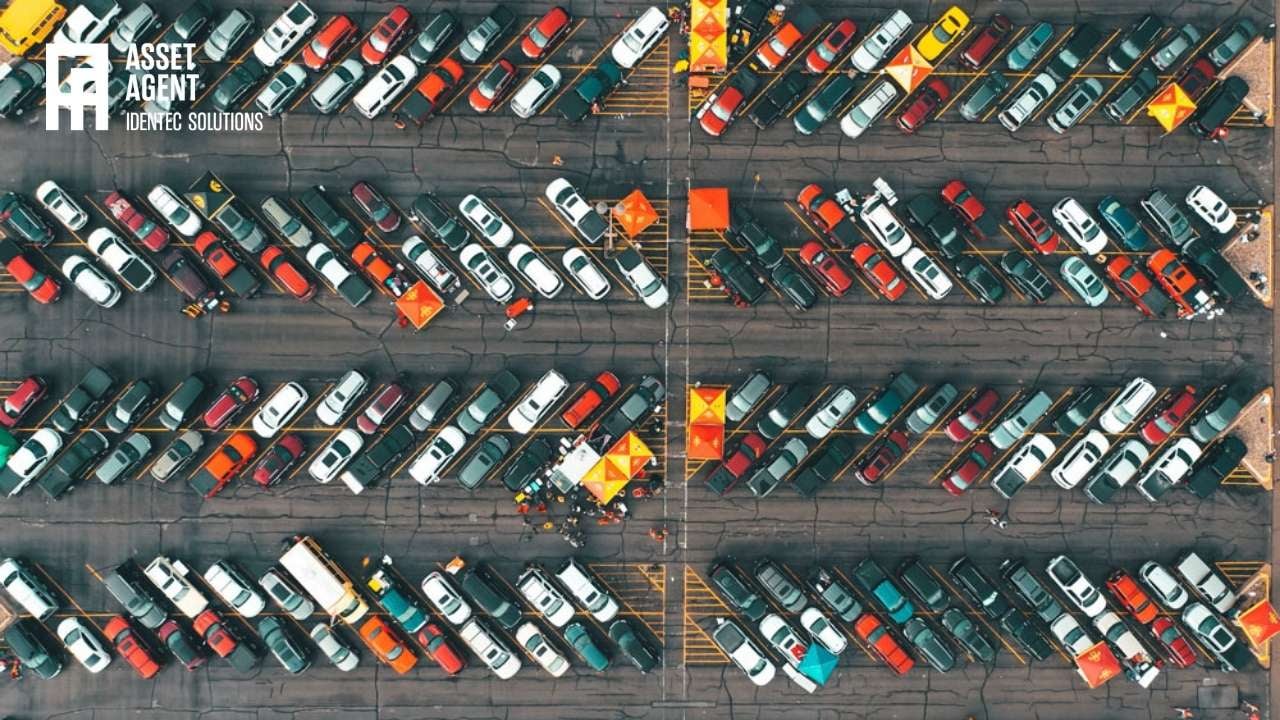Locating vehicles in the car park - automatically
| Written by Christian Aadal

No video selected
Select a video type in the sidebar.
In 2023, 16,835 franchised light-vehicle dealers in the US sold 15.5 million light-duty vehicles. At the same time, they wrote more than 264 million repair orders, with service and parts sales exceeding $142 billion (1).
There is a haystack, and then there is a needle. You don't need to hear more to understand the challenge of giant car terminals, aren't you? Several thousand vehicles, parked in lines and rows, polished and clean, advertised by second-hand car dealers. Cars waiting to get visited and picked up by future buyers, the valuable, vacant space replenished as soon as possible. Space is money, and so time is. A car dealer's yard is a place of continuous movement.
How Do Car dealers Manage their car parks?
Car dealerships manage their large car parks through a combination of strategic organisation, the use of technology, and efficient inventory management. The administration of such car parks can be a complex and time-consuming task. We collected some of the most important aspects of car management at big parking lots for a quick overview:
Strategic Organization of the Lot: It's crucial to organise the lot considering how employees and visitors use it. For instance, in a dealership, the most attractive sale options and new arrivals should be placed at the front, while trade-in vehicles can be in the back. Impound lots might place recently impounded vehicles near the entrance for easy retrieval.
Data-Driven Inventory Decisions: In the rapidly changing automotive market, dealerships utilise customer data from their Dealer Management Systems (DMS) and Customer Relationship Management (CRM) systems. This data helps identify trends, consumer preferences, and the performance of different makes and models on the lot. Advanced marketing tools that integrate this data can assist dealerships in making informed, real-time decisions about their inventory.
Maximising Pre-Owned Vehicle Inventory: Given the competitive nature of the pre-owned market, dealerships are more selective about sending vehicles to auction. They instead focus on reconditioning and retailing older models on their lots, considering factors like a vehicle's maintenance and accident history and changing consumer buying behaviours.
Compact Towing Options: To maximise space utilisation, smaller, more compact towing options like forklift wheel lift attachments can be more beneficial than large tow trucks. These allow for retrieving vehicles from smaller spaces and require less turnaround space, thus saving on overhead costs and improving efficiency.
In conclusion, managing large car parks in car dealerships involves a multi-faceted approach that includes efficient use of technology, strategic organisation, and a focus on both new and pre-owned vehicle inventory management, all underpinned by data-driven decision-making.
The goal: excellent customer experience
How is a used car sold these days? It all begins online. Marketplaces and large platforms dominate the online market in general, and car dealers are no different. Potential buyers love to have an enormous selection. This is the USP of large car dealers, who can offer "everything for everyone" and will do anything to show you your cars in their yard as well.
Typically, you will bookmark offers, print them out or book them online for a later visit. Everything is at your fingertips: costs, driven kilometres, horsepower, colour, and initial registration. You are ready to go because you like cars and you love the experience of using the website.
The top reasons for shopping in person are to test drive cars (89%), to complete deals one-on-one with the salesperson (82%) and to experience the car before purchase (79%). These potential customers still like to visit the car dealership and get a feel of the vehicle before completing a purchase (2).
Learn more about real-time locating and the success at the VW factory in Bratislava.

How does a Car Dealer Locate his vehicles?
Finding a specific car in a huge car park, especially at a car dealership, typically involves a few key steps:
- Vehicle Inventory Management Systems: Many large car parks and dealerships use vehicle inventory management software. This software catalogs each car's details such as VIN, license plate number, make, model, and its location in the car park. By accessing this system, one can quickly identify the exact location of a specific car.
- Strategic Organization of Cars: Car parks are often organised strategically. For example, new arrivals, popular models, or vehicles ready for sale might be placed in specific, easily identifiable areas.
- Signage and Markings: Car parks often have clear signage and markings, such as row numbers, section identifiers, or color-coded areas, which can aid in navigating to a specific location.
- Assistance from Staff: In a dealership or large car park, staff members are usually available to assist in locating a specific car. They are familiar with the layout and the organisational system in place.
Using these methods, one can efficiently locate a specific car in a large car park, in theory. What you need is accurate data, and this can be a challenge in a car park with many visitors.
The right way: Process visibility everywhere
Once you arrive at the car dealer for your booked appointment, you are ready to rock'n roll. You enter the building, tell the clerk your name, and she finds your appointment immediately and the cars in the vehicle inventory management system. All four cars are still available. You get the keys, and some instructions on what to do and what not. She takes a cheap paper copy of the yard map and explains in which zone your cars are parked. You nod, and off you are. Seven minutes later, in the middle of several thousand cars and signposts, you take a deep breath. You are lost, you know it, and you are annoyed to walk back to the office and ask for help. Your initial trust in this car dealer vanishes. If they can't manage the parking of their cars, how do they manage the functional capability? You are shaking your head, remember the other advertisement from another dealer and get your phone out. You will be there in fifteen minutes (read more about RTLS and RFID). Accurate location data is needed but is not the exclusive ingredient of customer satisfaction.
The missing link to full digitalisation: Asset Agent
The process at the second car dealer starts the same. But instead of a not-so-helpful map, you get the current parking position of your car. As you walk out to the dedicated parking zone, you click the button of the transponder the clerk gave you with the keys, and you immediately see the car's red light blinking. You found it with no time lost. That worked like a charm: you sit in the car, start the engine, drive a couple of rounds within the giant yard and park the car at one of the empty parking spaces. A car dealer's yard is a place of continuous movement.
The centrepiece of this magic is Asset Agent. Asset Agent is an asset management system. It uses a multi-functional transponder that is temporarily positioned on every vehicle and enables a real-time locating system (RTLS). When a "new" car arrives at the yard, the transponder is hung onto the inside mirror, and the car is associated with the transponder automatically. From this moment on, each vehicle's movement is tracked. Every new parking position will be automatically reported to the system and will be visible to the clerk and the visitor. All the time. If a car needs to be picked up or moved, an integrated LED in the transponder can initiate a flashing light for fast and easy identification of the right vehicle.
FAQ: Car Park Management at Car Dealerships
How do car dealerships manage large inventories in their car parks?
Dealerships use vehicle inventory management software to track every car’s location and details. They also strategically organise their lots, placing high-demand or new arrivals in accessible areas, while less frequently moved vehicles are stored further back. This organisation is supported by clear signage and markings for easy navigation.
What technology is used for efficient car park management?
Beyond inventory management software, dealerships may employ solutions like Asset Agent, which offer features real-time monitoring and locating individual vehicles with the help of LED-lights. These technologies streamline car park administration, improve space utilisation and increase customer experience.
How is space maximised in dealership car parks?
Dealerships maximise space by using compact towing options like forklift wheel lift attachments, which require less space than large tow trucks. Additionally, the thoughtful arrangement of vehicles, based on frequency of movement and sale potential, helps in utilising space effectively. Efficient space management is crucial due to the limited area and the constant movement of vehicles.
Takeaway
In managing large car parks, car dealerships adopt a multi-faceted approach that balances technology, strategic organisation, and data-driven inventory management. The key lies in efficiently utilising space, and optimising vehicle accessibility. By employing vehicle inventory management systems and real-time location, dealerships ensure operational efficiency and space maximisation. These practices not only streamline the car park management process but also enhance the customer experience by providing quick and accurate vehicle access. Ultimately, this sophisticated management approach reflects the evolving nature of automotive retail, where precision, efficiency, and customer satisfaction are paramount.
Do you want to learn more about Asset Agent' RTLS?
Extended reading: Real-time locating system and industry 4.0
Glossary
LED (Light Emitting Diode) lighting is a highly energy-efficient technology that produces light by passing an electrical current through a semiconductor material, causing it to emit photons. LEDs are long-lasting, durable, and emit minimal heat compared to traditional bulbs. They are widely used in residential, commercial, and industrial settings for applications such as lighting, displays, and indicators due to their energy savings and environmental benefits. (3)
Sources:
(1) https://www.nada.org/nada/nada-data
(2) https://www.pwc.com/us/en/industrial-products/publications/assets/pwc-2022-car-consumer-and-dealer-survey.pdf
(3) Holonyak, N., & Kish, F. (2017). LEDs: The Basics and Beyond. Cambridge University Press.
Note: This article was updated on the 16th of January 2025

Author
Christian Aadal, Product Manager
Christian Aadal holds a degree in Information & Communications Technology and Media and has several years of experience in the Telecom industry, working for some of the top names in the business. From a technical support engineer to project engineer, Global Product Manager - Asset Agent to sales, Christian prides himself on being able to understand industry needs with a focus on optimization, digitalization and security. His experience in the field gives him the ability to provide solutions for customers that can best meet their requirements and generate the value they are looking for. His passion is around Industry 5.0, where humans can bring out max efficiency in machines, and machines can bring out max efficiency of humans.



